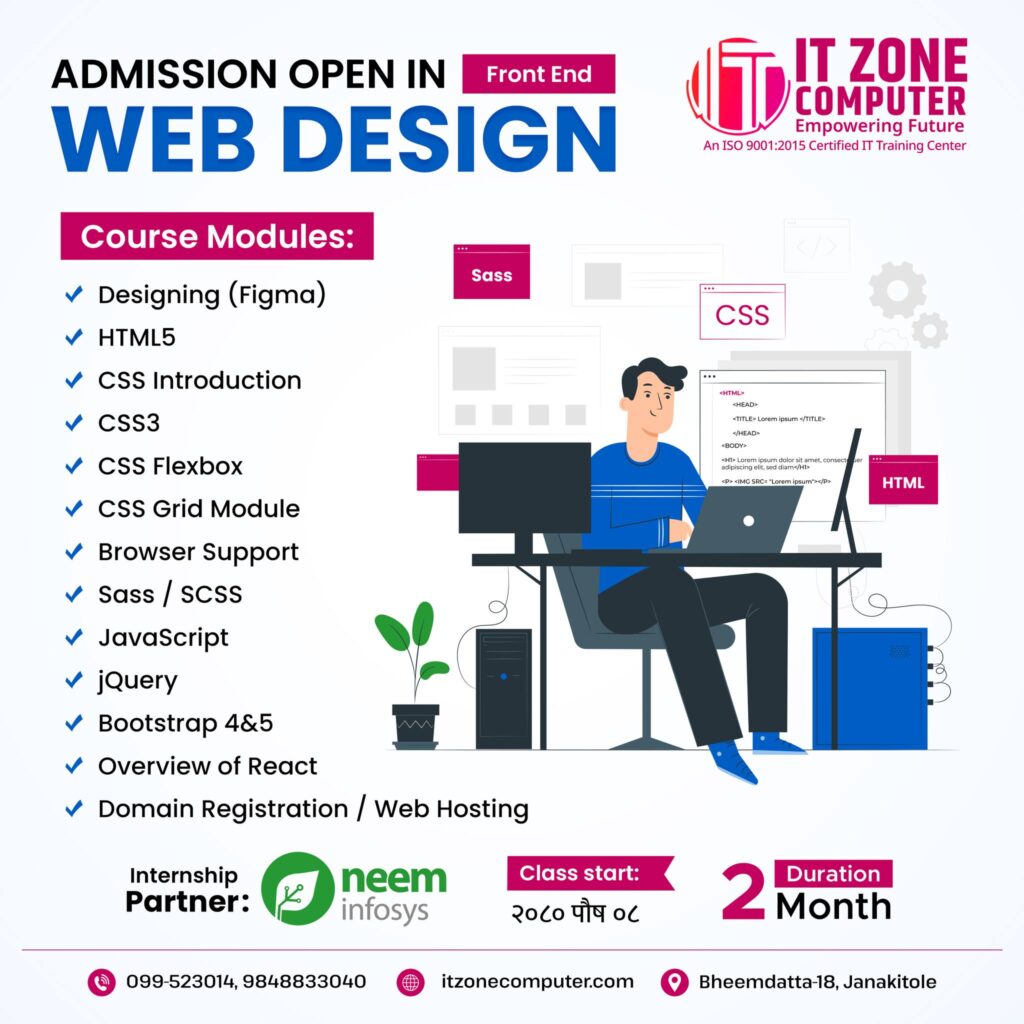About This Course
The Graphics Designing course provides a comprehensive understanding of graphic design principles and practical skills using industry-standard software such as Adobe Illustrator and Adobe Photoshop. Whether you're a beginner or have some prior experience in design, this course enhances your abilities and enables you to create visually appealing graphics and illustrations. You will learn the fundamentals of graphic design, including workspace customization, control palettes, and menus. Through hands-on exercises, you will gain proficiency in using tools, working with vectors and bitmaps, manipulating text, shapes, and colors. The course covers various drawing techniques, symbol usage, logo development, and special effects. Additionally, you will explore advanced topics such as paths, printing, and file optimization. By the end of the course, you will have acquired the skills needed to create captivating designs for both print and digital media.
Benefits of Graphic Design Training
- Enhance Creativity: Develop your creative skills and unleash your artistic potential through graphic design. Learn to think critically, conceptualize ideas, and translate them into visually appealing designs.
- Professional Software Proficiency: Gain proficiency in industry-standard graphic design software such as Adobe Illustrator and Adobe Photoshop. Acquire practical skills in using various tools, palettes, and menus to create professional-quality designs.
- Versatile Design Skills: Master the essential elements of graphic design, including composition, typography, color theory, and layout principles. Acquire the skills to create logos, illustrations, posters, brochures, and other visual materials for both print and digital media.
- Efficient Workflow: Discover time-saving techniques and shortcuts that streamline your design process. Learn how to use workspace customization, smart guides, and navigation shortcuts to work more efficiently and effectively.
- Portfolio Development: Build a comprehensive portfolio showcasing your design projects and demonstrate your proficiency to potential clients or employers. Learn how to present your work effectively and develop a professional design portfolio.
- Industry Insights: Gain insights into the latest trends and practices in the graphic design industry. Stay updated with current design standards, emerging technologies, and design principles to create contemporary and visually impactful designs.
- Career Opportunities: Develop a strong foundation in graphic design that can open doors to various career opportunities. Whether you aspire to work as a freelance designer, join a design agency, or pursue a career in marketing and advertising, the skills acquired in this course will be invaluable.
- Industry-Recognized Certification: By successfully completing the web designing course, you’ll receive a certification that is recognized by employers in the industry. This certification validates your skills and knowledge, making you stand out from other candidates during job interviews.
Career Options Graphic Design Training
- The Web Designing Course equips students with the necessary skills and knowledge to embark on a successful career in web design and development. Whether aspiring to work for an organization or establish a freelance career, this course provides a solid foundation to thrive in the dynamic field of web design.
- Graphic Designer: Work as a graphic designer for design agencies, marketing departments, or as a freelance professional. Create visual designs for branding, advertising, packaging, and various marketing materials.
- UI/UX Designer: Specialize in user interface (UI) and user experience (UX) design for digital products, such as mobile apps and software interfaces. Create intuitive and visually appealing designs that enhance user satisfaction and engagement.
- Brand Identity Designer: Develop visual identities and brand guidelines for businesses and organizations. Create logos, color schemes, typography systems, and other design elements that convey a consistent brand image.
- Print Production Artist: Work in the print industry, preparing designs for production. Ensure proper file formats, color management, and layout adjustments to meet the requirements of various print mediums, such as brochures, posters, and packaging.
- Motion Graphics Designer: Create animated visual content for various mediums, including videos, presentations, and advertisements. Use your design skills to bring static graphics to life through motion, enhancing the overall visual experience.
Pre-requisites for Graphic Design Training
Interested anyone can join this course.
Share :
Curriculum
- Custom workspace
- Control Palettes & menus
- Smart Guides
- Rulers, guides, grids, snap to
- Outline & Preview modes
- Navigation & Scroll shortcuts
- How Illustrator Works
- Components for Images
- Vectors v Bitmaps
- Text, Shapes & Colour
- Using the shape tools
- Transforming tools
- Drawing with the line tools
- The ‘warp tool’ flyout
- Symbols in Illustrator
- Developing a logo
- Tin can drawing
- Spoked wheel drawing
- Selecting, Copying and Moving
- Rotating, Skewing, Aligning, Grouping and Duplicating Objects
- Locking and Hiding
- Special Effects and alterations
- Drawing Tools such as rectangle, ellipse, polygon, Star
- Fills and Colors
- Drawing curves
- The Average and Join commands
- Eraser tool
- Importing & placing images
- Turning Bitmap into Vector
- Color
- Basic Colors & Stroke palette
- Types of Color; Color modes
- Spot v Process colors
- Gradient and Patterns
- Dragging color
- Understanding & using ‘stroke’ and ‘fill’ attributes
- Using Swatches
- Use the Paint Bucket tool
- Creating Text objects
- Artistic and Paragraph text
- Coloring and Filling text
- Adding ‘point’ type and ‘area’ type
- Add type to a vector path
- Create type outlines
- Linking Paragraphs
- Type Effects
- Placing Text Around Objects
- Find & replace & Spellcheck
- Using ‘group’ and ‘duplicate’
- Layer objects hiding and locking
- Using ‘isolation mode’
- Using Align and Distribute
- Compound paths
- Clipping masks
- Creating & Editing Paths
- Pen Tool
- Draw straight lines
- Draw continuous curves
- Shift an anchor point or a line
- Convert smooth points into corner
- Convert points in an existing object
- A curve shaping
- Converting an anchor point
- Pinch a curve inward
- Add, adjust, delete points
- Bezier curves
- Previewing
- The Print Dialog & Printing
- Defining a crop area
- Saving in non-Vector formats
- Save for Web
- Edit a brushstroke to an existing path
- Conversion of a brushstroke to outlined paths
- Creation and modification of brushes
- Create a new brush library
- Edit a scatter, art or pattern brush
- Draw using Paintbrush tool
- Object filling using a gradient
- Creation and modification of gradient
- Use the Gradient tool
- Create and edit Gradient meshes
- Rotate, Scale or shear
- Flip and slant
- The bounding box
- Use the Free Transform tool
- Creation and modification(Editing) of layers
- Create a sub layer
- Hide and Lock
- The layers Palette
- Removal of layer effects
- Live shapes with text
- 3D Shapes with Revolve
- Applying a Convert to Shape effect
- Inner/Outer Glow & Add Arrowheads
- Automatically trace artwork
- Converting objects
-
- Scribble, tweak & Twist
- Puker or bloat an object
- Rough up a shape
- Rotating path points
- Raster filters
- Pen and Ink filter
- The Photoshop Screen
- Getting to know the Tools & Palettes
- Utilizing guides, grids and rulers
- Zoom shortcuts and convenient navigation
- The InDesign Workspace
- Using shortcuts
- Your workspace customization
- Fixing preferences – rulers, guides, layers
- Develop Master Pages
- Altering Layout
- Manage Text and Graphic Placement
- Create the Structure of a Document
- Develop Layers
- The Selection and Direct Selection Tool
- The Tool & Color Palettes
- Grids, rulers and guides
- Add/Edit & Spell Check
- Threading , Wrapping and Importing Text
- Applying and Editing Styles to text
- Change Text Threads
- Deal with missing fonts
- Hyphenation and justification
- The Eyedropper tool
- Drop caps creation
- Editing, Applying and Managing Paragraph Styles
- Formatting Characters and Paragraphs
- Proper Numbering of paragraphs
- Place Text on a path
- Flow text through multiple frames
- ‘Placeholder’ frames creation
- Text options
- Using the ‘tab’ command
- The Glyphs window
- Aligning, Arranging and Distributing
- The ‘place’ command
- Images and frames resizing
- Using ‘text wrap’
- Managing object layers
- Rotating objects
- Creating special effects
- Shape and corner options>
- Transforming Objects
- Group & Ungroup
- Duplicating, Rotating, Scaling, Skewing, Mirroring
- Managing Transparency
- Settings for ‘fill’ and ‘stroke’
- Adding and converting Pantone colors
- Create, use and edit solid colors and gradients
- Threading/unthreading frames
- Flowing text through frames and Multi-column text frames
- Using special characters
- Hanging punctuation
- Composition options
- Document baseline grids
- Common Graphic file formats
- Import & Enhance Graphics Files
- Simple, compound & custom Image Frames
- Fitting options
- Inline graphics
- Creating Text Run-arounds
- Tolerance and threshold options
- Clipping Paths, Alpha channels
- Inner Shadow
- Gradient Feather
- Bevel and Emboss
- Inner and Outer Glow
- Create, Modify and Format a Table
- Using multiple master pages
- Adding and deleting pages
- Working with master pages
- Automatic page numbering
- Creating new numbering sections
- The ‘book’ option
- Templates and libraries
- Importing swatches
- Using Adobe Bridge
- Checking documents for problems
- Printing
- Package Files
- PostScript, preflighting and Packaging
- Preview Output & options
- Print, Separation, Flattening
- Creating high and low resolution Adobe Acrobat PDF Files
- Creating a low-res PDF for the web
- Why use Selections?
- Creating selections using Marquee tools
- The Magic Wand and Quick Selection tool
- The Lasso tools
- Adding or Deleting from selections
- Saving and Loading selections
- Tonal Values Control
- Toned and Tinted Images creation
- Selecting by color range
- Feathering selections
- Quick Mask mode
- Properly Using the Histogram palette
- Fixing color with variations
- Using Levels and Curves to fix tone & contrast
- Color balance and variations
- Hue and saturation controls
- The Vibrance command
- Color correction using AI platforms and final compilation in Photoshop
- Custom colors
- Dodge and burn tools
- Crop and rotate artwork
- Sharpen and Blur filters
- Focus tools
- The Clone & Heal tools
- The Healing Brush tools
- The Color Replace tool
- Red eye reduction
- Digital darkroom techniques
- Gradients creation and editing
- Using Plug-ins and filters
- Using the Unsharp Mask
- Cloning Images
- Using the Burn/Dodge/Sponge Tools
- Print and web safe colors
- Mixing and applying paint and fill colors
- Using the Paint Bucket tool
- Using the Airbrush, Pencil, Paintbrush and Eyedropper tools
- Drawing shapes
- Creating vector shape layers
- Polygon, line and custom shape tools
- Adding, subtracting, intersecting commands
- Editing vector shapes using the pen tools
- Adding color fills, patterns and gradients
- Introducing in Mid Journey AI platform
- Writing script to generate AI images for designing
- Multiple Layers creation and viewing
- Moving, scaling and rotating layers
- Linking & aligning Layers
- Merging, Flattening and Saving Layers
- Locking and protecting layers
- Layer groups
- Applying and editing type
- Converting shape and text layers
- Saving and flattening layered files
- Applying transparency
- Fundamental modes of layer blending
- Text and adjustment layers
- Special effects
- Drop shadows, glows and embossing
- Layer masks
- Fresh Features
- Text Layer Creation
- Text Paragraphs
- Adding Text Effects,
- Painting Text
- Anti-aliasing Text
- Introducing ChatGPT
- Creating content for designing material
- Frame Animation
- Video timeline
- gif file export
- Photoshop filters utilization
- Working with the Filter Gallery
- Fading the effects of filters
- File formats
- Right color mode selection
- Adjusting resolution and image size
- Canvas cropping and enlargement
- Printing and Optimizing Documents
- Color modes, resolution & image size
- Printing from Photoshop and other Applications
- The Save for web command
- Developing Transparent GIF files
As per the Institute Rules, four of the following projects will be done by the student themselves! For Final Project
- Brand Identity Design
- Packaging Design
- Poster Design
- Infographic Design
- Magazine Layout Design
- Social Media Design
- Logo Design
- Book Cover Design
Instructor
What Our Students Say
"All We Care About is Quality"

Manoj Kumar Singh
(BBS (Far-western University ))As a student exploring the vast world of technology, my experience with IT ZONE has been nothing short of exceptional. This company has been an invaluable resource on my journey to understanding and mastering various IT concepts.

Jagriti Shahi
(BBS (Far-western University ))I can't express enough how grateful I am to have discovered IT Zone during my journey as a student in the field of IT. This company has not only expanded my knowledge but also transformed the way I approach technology.
Success Stories
"Quality Never Say Sorry"
Offers
"View Our Offers Here!"
Join Us in Shaping the Future of Technology
Join us to define technology's future, innovate, push boundaries, create solutions, and drive a brighter tomorrow.

Upcoming Classes

Duration: 2 months





Average Rating
4.5
508 ratings
Detailed Rating